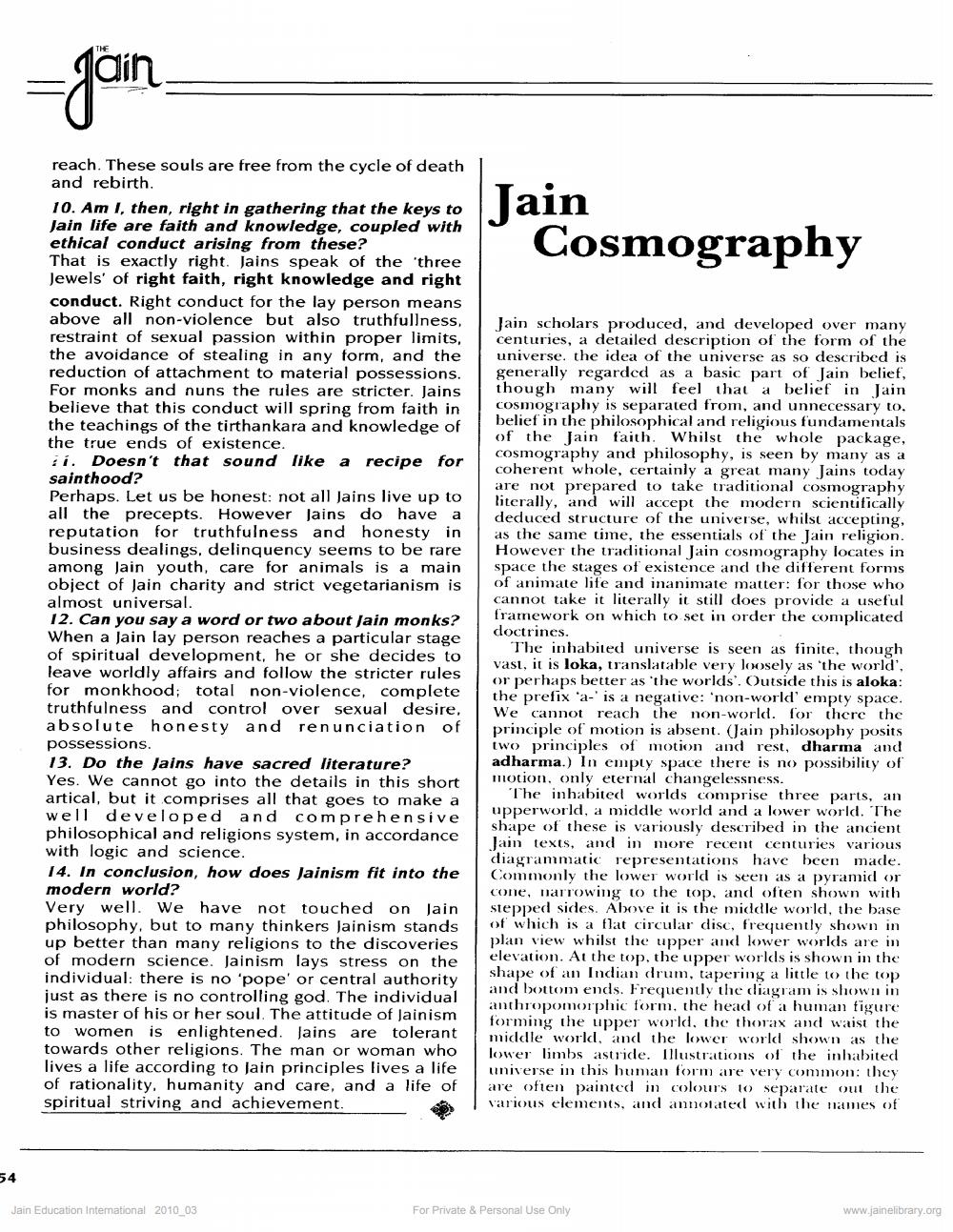________________
again
Jain
Cosmography
reach. These souls are free from the cycle of death and rebirth. 10. Am I, then, right in gathering that the keys to Jain life are faith and knowledge, coupled with ethical conduct arising from these? That is exactly right. Jains speak of the three Jewels' of right faith, right knowledge and right conduct. Right conduct for the lay person means above all non-violence but also truthfullness, restraint of sexual passion within proper limits, the avoidance of stealing in any form, and the reduction of attachment to material possessions. For monks and nuns the rules are stricter. Jains believe that this conduct will spring from faith in the teachings of the tirthankara and knowledge of the true ends of existence. ii. Doesn't that sound like a recipe for sainthood? Perhaps. Let us be honest: not all Jains live up to all the precepts. However Jains do have a reputation for truthfulness and honesty in business dealings, delinquency seems to be rare among lain youth, care for animals is a main object of Jain charity and strict vegetarianism is almost universal. 12. Can you say a word or two about Jain monks? When a Jain lay person reaches a particular stage of spiritual development, he or she decides to leave worldly affairs and follow the stricter rules for monkhood; total non-violence, complete truthfulness and control over sexual desire, absolute honesty and renunciation of possessions. 13. Do the Jains have sacred literature? Yes. We cannot go into the details in this short artical, but it comprises all that goes to make a well developed and comprehensive philosophical and religions system, in accordance with logic and science. 14. In conclusion, how does Jainism fit into the modern world? Very well. We have not touched on Jain philosophy, but to many thinkers Jainism stands up better than many religions to the discoveries of modern science. Jainism lays stress on the individual: there is no 'pope' or central authority just as there is no controlling god. The individual is master of his or her soul. The attitude of Jainism to women is enlightened. Jains are tolerant towards other religions. The man or woman who lives a life according to Jain principles lives a life of rationality, humanity and care, and a life of spiritual striving and achievement.
Jain scholars produced, and developed over many centuries, a detailed description of the form of the universe. the idea of the universe as so described is generally regarded as a basic part of Jain belief, though many will feel that a belief in Jain cosmography is separated from, and unnecessary to belief in the philosophical and religious fundamentals of the Jain faith. Whilst the whole package, cosmography and philosophy, is seen by many as a coherent whole, certainly a great many Jains today are not prepared to take traditional cosmography literally, and will accept the modern scientifically deduced structure of the universe, whilst accepting, as the same time, the essentials of the Jain religion. However the traditional Jain cosmography locates in space the stages of existence and the different forms of animate life and inanimate matter for those who cannot take it literally it still does provide a useful framework on which to set in order the complicated doctrines.
The inhabited universe is seen as finite, though vast, it is loka, translatable very loosely as 'the world', or perhaps better as 'the worlds. Outside this is aloka: the prefix 'a-' is a negative: 'non-world' empty space. We cannot reach the non-world. for there the principle of motion is absent. (Jain philosophy posits two principles of motion and rest, dharma and adharma.) In empty space there is no possibility of motion, only eternal changelessness.
The inhabited worlds comprise three parts, an upperworld, a middle world and a lower world. The shape of these is variously described in the ancient Jain texts, and in more recent centuries various diagrammatic representations have been made. Commonly the lower world is seen as a pyramid or cone, narrowing to the top, and often shown with stepped sides. Above it is the middle world, the base of which is a flat circular disc, frequently shown in plan view whilst the upper and lower worlds are in elevation. At the top, the upper worlds is shown in the shape of an Indian drum, tapering a little to the top and bottom ends. Frequently the diagram is shown in anthropomorphic form, the head of a human figure forming the upper world, the thorax and waist the middle world, and the lower world shown as the lower limbs astride. Illustrations of the inhabited universe in this human form are very common: they are often painted in colours to separate out the various elements, and annotated with the names of
54
Jain Education Interational 2010_03
For Private & Personal Use Only
www.jainelibrary.org




